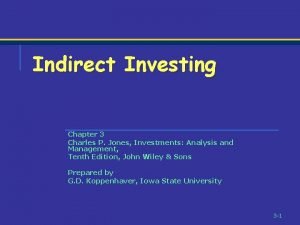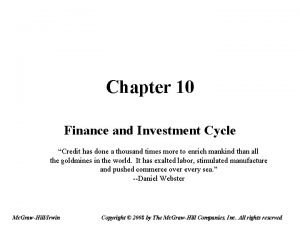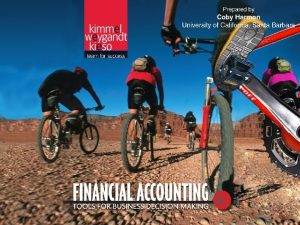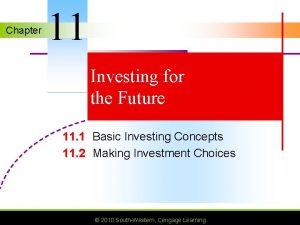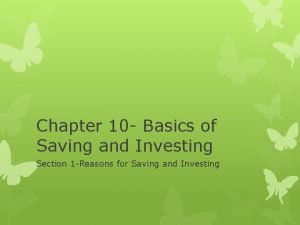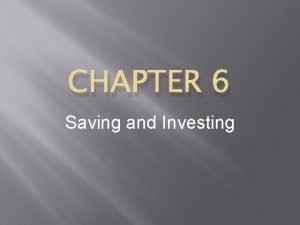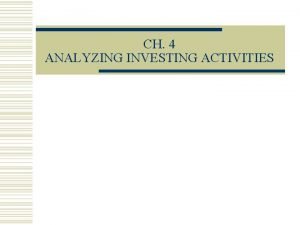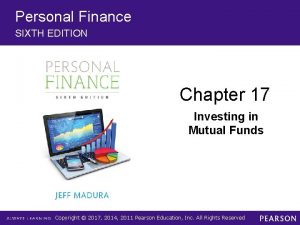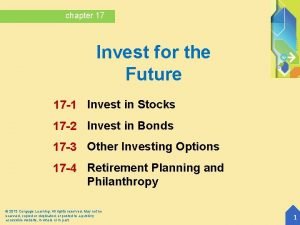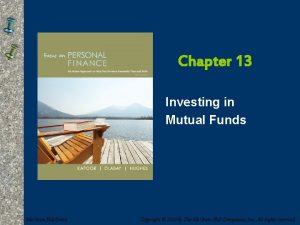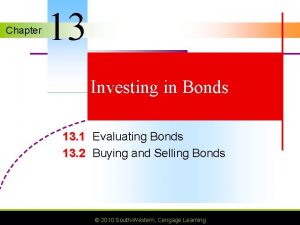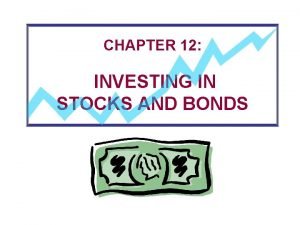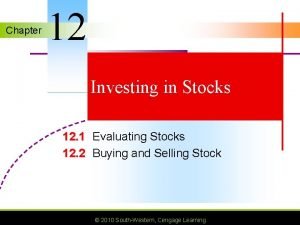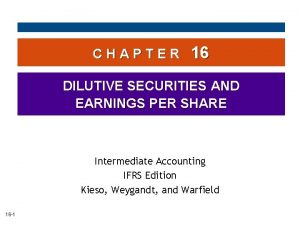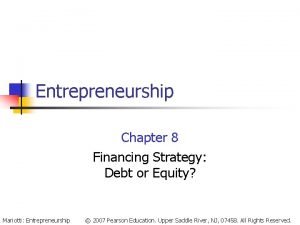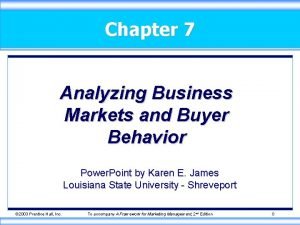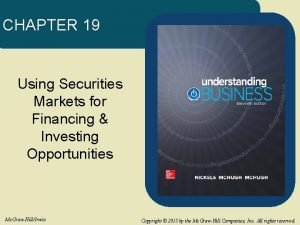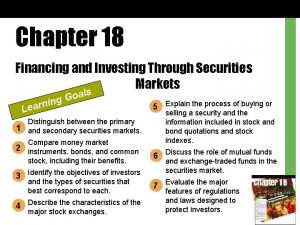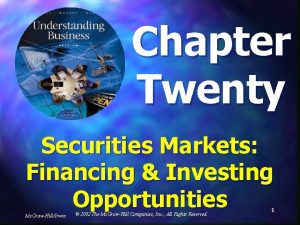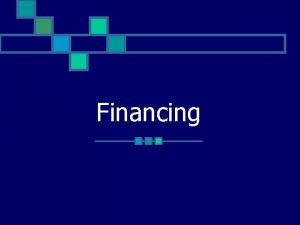Chapter Nineteen Using Securities Markets for Financing Investing




































- Slides: 36

* Chapter Nineteen * Using Securities Markets for Financing & Investing Opportunities Mc. Graw-Hill/Irwin Copyright © 2010 by the Mc. Graw-Hill Companies, Inc. All rights reserved.

The BASICS of SECURITIES MARKETS *The Function of Securities Markets LG 1 * • Securities markets are financial marketplaces for stocks and bonds and serve two primary functions: 1. Assist businesses in finding long -term funding to finance capital needs. 2. Provide private investors a place to buy and sell securities such as stocks and bonds. 19 -2

*The Function TYPES of SECURITIES MARKETS of Securities Markets * LG 1 • Securities markets are divided into primary and secondary markets: - Primary markets handle the sale of new securities. - Secondary markets handle the trading of securities between investors with the proceeds of the sale going to the seller. • Initial Public Offering (IPO) -- The first offering of a company’s stock. 19 -3

INVESTMENT BANKERS and INSTITUTIONAL INVESTORS *The Role of Investment Bankers LG 1 * • Investment Bankers -Specialists who assist in the issue and sale of new securities. • Institutional Investors -Large organizations such as pension funds or mutual funds that invest their own funds or the funds of others. 19 -4

STOCK EXCHANGES *Stock Exchanges http: //www. youtube. com/watch? v=reiru 4 Du 9 a. I * LG 2 • Stock Exchange -- An organization whose members can buy and sell securities on behalf of companies and individual investors. • Over-the-Counter (OTC) Market -- Provides companies and investors with a means to trade stocks not listed on the national securities exchanges. • NASDAQ -- A telecommunications network that links dealers across the nation so they can exchange securities. 19 -5

TOP STOCK EXCHANGES *Stock Exchanges LG 2 * • NYSE Euronext • NASDAQ • London Stock Exchange • Tokyo Stock Exchange • Deutsche Borse 19 -6

The SECURITIES and EXCHANGE COMMISSION *Securities Regulations and the SEC * LG 2 • Securities and Exchange Commission (SEC) -The federal agency responsible for regulating the various stock exchanges; created in 1934 through the Securities and Exchange Act. http: //www. sec. gov/ • Prospectus -- A detailed registration statement that includes extensive economic and financial information that must be sent to prospective investors. 19 -7

PROGRESS ASSESSMENT * Progress Assessment * • What’s the primary purpose of a stock exchange? • Can you name the world’s largest stock exchange? • What does NASDAQ stand for? How does this exchange work? 19 -8

LEARNING the LANGUAGE of STOCKS * Learning the Language of Stocks LG 3 * • Stocks -- Shares of ownership in a company. • Stock Certificate -Evidence of stock ownership. • Dividends -- Part of a firm’s profits that the firm may distribute to stockholders as either cash or additional shares. 19 -9

ADVANTAGES of ISSUING STOCKS * Advantages & Disadvantages of Issuing Stock LG 3 * • Stockholders are owners of a firm and never have to be repaid their investment. • There’s no legal obligation to pay dividends. • Issuing stock can improve a firm’s balance sheet since stock creates no debt. 19 -10

DISADVANTAGES of ISSUING STOCK * Advantages & Disadvantages of Issuing Stock LG 3 * • Stockholders have the right to vote for a company’s board of directors. • Issuing new shares of stock can alter the control of the firm. • Dividends are paid from after-tax profits and are not tax deductible. • The need to keep stockholders happy can affect management’s decisions. 19 -11

* TWO CLASSES of STOCK Issuing Shares of Common Stock * LG 3 • Common Stock -- The most basic form; holders have the right to vote for the board of directors and share in the profits if dividends are approved. • Preferred Stock -- Owners are given preference in the payment of company dividends before common stock dividends are distributed. Preferred stock can also be: - Callable - Convertible - Cumulative 19 -12

PROGRESS ASSESSMENT * Progress Assessment * • Name at least two advantages and disadvantages of issuing stock as a form of equity financing. • What are the major differences between common stock and preferred stock? 19 -13

LEARNING the LANGUAGE of BONDS *Learning the Language of Bonds LG 4 * • Bond -- A corporate certificate indicating that an investor has lent money to a firm. • The principal is the face value of the bond. • Interest -- The payment the bond issuer makes to the bondholders to compensate them for the use of their money. 19 -14

ADVANTAGES of ISSUING BONDS * Advantages & Disadvantages of Issuing Bonds * LG 4 • Bondholders are creditors, not owners of the firm and can’t vote on corporate matters. • Bond interest is tax deductible. • Bonds are a temporary source of funding and are eventually repaid. • Bonds can be repaid before the maturity date if they contain a call provision. 19 -15

DISADVANTAGES of ISSUING BONDS * Advantages & Disadvantages of Issuing Bonds LG 4 * • Bonds increase debt and can affect the market’s perception of the firm. • Paying interest on bonds is a legal obligation. • If interest isn’t paid, bondholders can take legal action. • The face value of the bond must be repaid on the maturity date. 19 -16

* BOND RATINGS Advantages & Disadvantages of Issuing Bonds http: //www. youtube. com/watch? v=q 3 RPe. Bt. I 6 Yc LG 4 * Rating Moody’s Standard & Poor’s Description Aaa AAA Highest Quality Aa AA High Quality A A Upper-Medium Grade Baa BBB Medium Grade Ba BB Lower-Medium Grade B B Speculative Caa CCC, CC Poor Ca C Highly Speculative C D Lowest Grade 19 -17

DIFFERENT CLASSES of CORPORATE BONDS *Different Classes of Bonds LG 4 * • Corporations can issue two classes of bonds: 1. Unsecured bonds (debenture bonds): not backed by specific collateral. 2. Secured bonds: backed by collateral (land or equipment). 19 -18

SPECIAL FEATURES in BOND ISSUES *Special Bond Features * LG 4 • Sinking Fund -- Reserve account set up to ensure that enough money will be available to repay bondholders on the maturity date. • Callable bonds permit bond issuers to pay off the principal before the maturity date. • Convertible bonds allow bondholders to convert their bonds into shares of common stock. 19 -19

PROGRESS ASSESSMENT * Progress Assessment * • Why are bonds considered a form of debt financing? • What does it mean if a firm issues a 9% bond due in 2025? • Explain the difference between an unsecured and secured bond. • Why are convertible bonds attractive to investors? 19 -20

BUYING SECURITIES *How Investors Buy Securities LG 5 * • Stockbroker -- A registered representative who works as a market intermediary to buy and sell securities for clients. • Online trading services, such as TD Ameritrade, E*Trade, and Scottrade, offer securities trading services online to buy and sell stocks and bonds. 19 -21

FIVE INVESTMENT CRITERIA * Choosing the Right Investment Strategy http: //www. youtube. com/watch? v=r. Irt. QC-p. Hk. Y LG 5 * 1. Investment risk 2. Yield 3. Duration 4. Liquidity 5. Tax consequences 19 -22

AVERAGE ANNUAL RETURN of ASSET CLASSES (1926 -2007) Investment * LG 5 * Return Small company stocks 12. 2% Large company stocks 9. 5% Corporate bonds 6. 0% Long-term government bonds 5. 8% Treasury bills 4. 1% Source: Ibbotson Associates and Morningstar. Choosing the Right Investment Strategy 19 -23

PROGRESS ASSESSMENT * Progress Assessment * • What’s the key advantage of investing through online brokers? What’s the key disadvantage? • What’s the primary purpose of diversifying investments? 19 -24

BEAR MARKET DECLINES in the S&P 500 Time Period % Drop in Prices 2007 -2009 52. 5% 2000 -2002 51% 1973 -1974 48. 2% 1968 -1970 36. 1% 1987 -1988 33. 5% Source: Stock Traders Almanac 2009. *Investing in Stocks LG 6 * 19 -25

SELECTING STOCKS *Investing in Stocks LG 6 * • Capital Gains -- The positive difference between the price at which you bought a stock and what you sell it for. • Investors can also choose stocks according to their strategy: - Blue-chip stocks Growth stocks Income stocks Penny stocks 19 -26

STOCK SPLITS * Stock Splits LG 6 * • Stock Splits -- An action by a company that gives stockholders two or more shares of additional stock for every share that’s outstanding. • Splits cause no change in the firm’s ownership structure and no change in the investment’s value. • Firms can never be forced to spilt their stocks. 19 -27

BUYING STOCK on MARGIN * Buying Stock on Margin * LG 6 • Buying Stock on Margin -- Borrowing some of the stock’s purchase cost from the brokerage firm. • Margin is the portion of the stock’s purchase price that the investor must pay with their own money. • If a broker issues a margin call, the investor has to come up with money to cover losses. 19 -28

TOP FINANICIAL NEWS and RESEARCH SITES *Understanding Stock Quotations LG 6 * • Yahoo Finance • AOL Money and Finance • MSN Money • Forbes • Dow Jones & Co. Source: Entrepreneur Magazine, March 2009. 19 -29

* IMPORTANT BOND QUESTIONS Investing in Bonds * LG 7 • First-time bond investors generally ask two questions: - Do you have to hold a bond until the maturity date? - How can I assess the investment risk of a particular bond issue? • Junk Bonds -- Bonds that have a high risk and high default rates. 19 -30

* INVESTING in MUTUAL FUNDS and EXCHANGE-TRADED FUNDS Investing in Mutual Funds & Exchange. Traded Funds * LG 8 • Mutual Fund -- An organization the buys stocks and bonds and then sells shares in those securities to the public. The fund pools investors’ money and buys stocks according to the fund’s purpose. • Exchange-Traded Fund (ETF) -- Collections of stocks and bonds that are traded on securities exchanges but themselves are traded more like stocks than mutual funds. 19 -31

COMPARING INVESTMENTS * Investing in Mutual Funds & Exchange. Traded Funds LG 8 * 19 -32

PROGRESS ASSESSMENT * Progress Assessment * • What’s a stock split? Why do companies sometimes split their stock? • What does buying stock on margin mean? • What are mutual funds? • What’s the key benefit to investors in investing in a mutual fund? 19 -33

KEY STOCK MARKET INDICATORS * Understanding Stock Market Indicators * LG 9 • Dow Jones Industrial Average -- The average cost of 30 selected industrial stocks. • Critics say the 30 -company Dow is too small a sample and suggest following the S&P 500. • S&P 500 tracks the performance of 400 industrial, 40 financial, 40 public utility, and 20 transportation stocks. 19 -34

Original 12 Dow Stocks (1896) • American Cotton Oil • Laclede Gas Light Co. • American Sugar Refining Co. • National Lead • American Tobacco • North American Co. • Chicago Gas • Tennessee Coal, Iron, & Railroad Co. • Distilling & Cattle Feeding Co. • U. S. Leather • General Electric Co. 19 -35 • U. S. Rubber Co.

WHO’S at FAULT for the ECONOMIC CRISIS? * Investing Challenges in the 21 st Century Market * LG 2 • Wall Street - Issued exotic securities; paid excessive compensation based on bonuses; and investment banks got the SEC to relax capital requirement. • Main Street - Americans lived beyond their means; lenders gave favorable loans to homebuilders; greedy homeowners took out equity loans; and teaser mortgage rates let people live large. • Washington - Gramm-Leach-Billey Act allowed commercial and investment banks to partner; housing interest rates were kept low; and Community Reinvestment Act forced lending to people with bad credit. Source: Fortune Magazine, www. fortune. com. 19 -36
 Direct investing vs indirect investing
Direct investing vs indirect investing Financing and investing cycle
Financing and investing cycle What are plant assets
What are plant assets Operating activities indirect method
Operating activities indirect method How would you define efficient security markets
How would you define efficient security markets To room 19 book
To room 19 book In 1991
In 1991 Chapter 11 investing for the future
Chapter 11 investing for the future Chapter 10 basics of saving and investing
Chapter 10 basics of saving and investing Holding a variety of investments to reduce risk
Holding a variety of investments to reduce risk Chapter 6 saving and investing
Chapter 6 saving and investing Analyzing investing activities
Analyzing investing activities Chapter 17 investing in stocks
Chapter 17 investing in stocks Chapter 17 investing in stocks
Chapter 17 investing in stocks Chapter 13 investing in mutual funds
Chapter 13 investing in mutual funds Chapter 13 investing in bonds
Chapter 13 investing in bonds Chapter 12 investing in stocks
Chapter 12 investing in stocks Chapter 12 investing in stocks
Chapter 12 investing in stocks What is a marketable security
What is a marketable security Chapter 16 dilutive securities and earnings per share
Chapter 16 dilutive securities and earnings per share Chapter 8 financing a business
Chapter 8 financing a business Why study financial markets and institutions chapter 1
Why study financial markets and institutions chapter 1 Cultural dynamics in assessing global markets
Cultural dynamics in assessing global markets Consumer markets and consumer buyer behavior
Consumer markets and consumer buyer behavior Chapter 9 expanding markets and moving west
Chapter 9 expanding markets and moving west Analyzing business markets
Analyzing business markets Business buyer definition
Business buyer definition Chapter 18 the markets for the factors of production
Chapter 18 the markets for the factors of production Changes in an individual's behavior arising from experience
Changes in an individual's behavior arising from experience Analyzing consumer markets chapter 6
Analyzing consumer markets chapter 6 Chapter 5 consumer markets and buyer behavior
Chapter 5 consumer markets and buyer behavior Firms in competitive markets chapter 14 ppt
Firms in competitive markets chapter 14 ppt Chapter 9 expanding markets and moving west
Chapter 9 expanding markets and moving west Chapter 9 expanding markets and moving west
Chapter 9 expanding markets and moving west Chapter 7 consumers producers and the efficiency of markets
Chapter 7 consumers producers and the efficiency of markets Iso 22301 utbildning
Iso 22301 utbildning Typiska novell drag
Typiska novell drag
